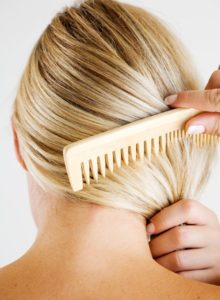Currently Craving: Healthy Hair and Scalp After Hair Loss
- Published: Sunday, September 20th 2015
- in Beauty
> Hereditary hair loss is a medical condition that affects about 30 million American women but did you know that there is another form of hair loss that can effect nearly every woman at some point in her life? TE (Telogen Effluvium) is a type of hair loss that is a direct result from stress – and chances are if you’ve looked in the mirror and thought your hair looked a little thinner than usual – you could be experiencing this common form of hair loss. I did, and I’m here to tell you there is a light at the end of the tunnel! I chatted with New York Dual-Board Certified Facial Plastic Surgeon and Leading Hair Restoration Specialist Dr. James C. Marotta to get the ins and outs of TE and I’m sharing products and treatments that have helped me (and many others) reclaim my crowning glory!
Hereditary hair loss is a medical condition that affects about 30 million American women but did you know that there is another form of hair loss that can effect nearly every woman at some point in her life? TE (Telogen Effluvium) is a type of hair loss that is a direct result from stress – and chances are if you’ve looked in the mirror and thought your hair looked a little thinner than usual – you could be experiencing this common form of hair loss. I did, and I’m here to tell you there is a light at the end of the tunnel! I chatted with New York Dual-Board Certified Facial Plastic Surgeon and Leading Hair Restoration Specialist Dr. James C. Marotta to get the ins and outs of TE and I’m sharing products and treatments that have helped me (and many others) reclaim my crowning glory!
To start it’s completely normal to shed, on average we lose anywhere from 50-100 hairs a day and during certain seasons we can shed a little more or a little less (remember that old wives tale that hair grows faster in the summer?). But it’s when shedding becomes noticeable that we need to find the root of the problem.To understand TE you must first understand the growing cycle of hair. Our hair follicles go through three distinct phases simultaneously: anagen, catagen, and telogen. Anagen is the growing stage and it can last from two-six years (the longer we stay in this phase the longer our strands will stretch – note: on average we grow .5 inch to an inch per month). Categen phase is the transitional phase where the follicle is renewing itself and Telogen phase is the resting phase – when the healthy cycle begins again the resting strand sheds and a new hair grows in its place.
TE is the second most common form of hair loss second to heredity hair loss (or androgenetic alopecia). “TE happens when there is a change in the number of hair follicles growing hair. If the number of hair follicles producing hair drops significantly for any reason during the resting, or telogen phase, there will be a significant increase in dormant, telogen stage hair follicles,” explained Dr. Marotta. “The result is shedding, or TE hair loss.” Often times you won’t notice TE right away as its a “diffuse thinning of the hair” rather than a mass falling out.
“It can be a bit more severe in some areas of the scalp than others,” says Dr. Marotta. “Most often, the hair on top of the scalp thins more than it does at the sides and back of the scalp.” But, there is a silver lining! Whatever form of hair loss you experience with TE it is reversible because the follicle itself is still healthy – there are just an excess of resting follicles.
There are three reasons why TE hair loss may happen:
- “There might be an environmental insult that ‘shocks’ the growing hair follicles so much that they decide to go into a resting state for a while. This results in an increase in hair shedding and a diffuse thinning of hair on the scalp. This form of TE can develop rapidly and may be noticeable one or two months after receiving the shock. If the trigger is short lived, then the hair follicles will return to their growing state and start producing new hair fibers pretty quickly. This form of TE usually lasts less than six months and the affected individual has a normal scalp hair density again within a year.
- “The second form of TE develops more slowly and persists longer. The hair follicles may not all suddenly shed their hair fibers and enter a resting telogen state. Rather, the follicles may enter a resting state as they normally would, but instead of returning to a new anagen hair growing state after a month or two, they stay in their telogen state for a prolonged period of time. This results in a gradual accumulation of hair follicles in a telogen state and progressively fewer and fewer anagen hair follicles are left growing hair. In this form of TE, there may not be much noticeable hair shedding, but there will be a slow thinning of the scalp hair. This form of TE is more likely to occur in response to a persistent trigger factor.”
- In a third type of TE, the hair follicles do not stay in a resting state but rather cycle through truncated growth cycles. When this happens, the individual experiences thin scalp hair and persistent shedding of short, thin hair fibers.
 Women may experience TE for a number of reasons but most commonly from pregnancy (postpartum shed – which can also occur when you go off or switch birth control pills), stress, and diet. “In the case of diet, TE can be triggered as a cause of deficient iron intake, and women lose iron at regular intervals as a result of menstruation,” explained Dr. Marotta.
Women may experience TE for a number of reasons but most commonly from pregnancy (postpartum shed – which can also occur when you go off or switch birth control pills), stress, and diet. “In the case of diet, TE can be triggered as a cause of deficient iron intake, and women lose iron at regular intervals as a result of menstruation,” explained Dr. Marotta.
“Many believe that chronic stress can gradually exert a negative effect on hair growth and lead to persistent TE,” says Dr. Marotta. “Additionally, a diet that is lacking in a mineral, vitamin, or essential amino acid can cause TE. However, this is seen more in third-world countries, where it is common for diets to be deficient of key nutrients. In the United States, some argue that the reduction of red meat in our diets causes many to have a much lower iron intake, which can result in TE.”
How can you prevent it?
Unfortunately there is no way to adequately predict if your follicles will be shocked by an event but you can take steps to prevent TE hair loss “though diet and stress reduction.” Also Dr. Marotta notes that women should ensure they are getting the proper vitamins and nutrients from their diet and should take supplements where needed (but always consult your physician!)
Fix it!
Dr. Marotta recommends: Topical minoxidil – “Available without a prescription [and] can be used to treat female pattern hair loss. It is applied to the scalp twice a day and must be used for at least four months before the patient will see results. Minoxidil can help reverse the shrinking process seen in these hair follicles and stimulates new hair growth.”
Editor’s note: Many believe that Topical minoxidil products must be used for life once you start them – but that’s only true when we’re discussing pattern hair loss (or hereditary causes) with TE your hair is going to grow back, this just helps to speed up the process!
My recommendations:
Three years ago I had a head of hair to be envied – it flowed all the way down my back, was thick, black, and in hindsight luxurious but after a bad straightening treatment (my advice now is to love the texture you were born with!) and a switch in medication I found myself not realizing my crowning glory was slowly becoming, well, not so glorious. It took a few candid pictures for me to realize I needed to start working on saving my scalp and my hair! Here are some products that worked and are still working for me:
LUSH – Roots Hair Treatment
Roots works on just that: the roots of your hair to make them healthy and revitalized, which leads to serious shine and va-va-volume—especially good for those with “thine” hair (LUSH’s word for thin + fine, aka—me). Thanks to peppermint and spearmint oils, the mask (which you leave on for 15-20 minutes in the shower) tingles and cools your scalp, and we all know the tingles mean it’s working. www.lushusa.com
Roy Teeluck’s Concentre de Collagene and In-Salon Treatment
This scalp treatment (and subsequent in-salon service) is formulated with a unique collagen delivery system enhanced with peptides and botanicals. Repeated use results in a healthy scalp which helps foster fuller hair. Each bottle contains about 60 applications. After receiving this treatment in the salon my hair (which at the time was at its worst) looked fuller immediately! Treatment available at Roy Teeluck Salon in NYC; $45 for wash, scalp massage, and steam (great to book along a blowdry!) Product available online at royteeluck.com
Lee Stafford Treatment For Hair That Never Grows Past a Certain Length
Yes it’s a mouthful – but it’s also a must-have for anyone looking to strengthen his/her scalp and grow longer hair. Using its Pro-Growth™ complex, the five-minute treatment “fertilizes follicles” and helps to promote a healthy environment for hair to reach its maximum potential. Simply put, for me, this treatment just works. I looked everywhere for a hair growth miracle and found it at the Duane Reade across the street from our SpaFinder® Wellness offices in the form of this tub of goop. You just massage one scoop of goop into the hair post shampoo and pre-condition every time you wash your hair (and then just one time each week once you see a difference). After the first tub you will be thanking us! 6.7 fl. oz., ulta.com
To supplement these products I really recommend sipping on Rooibos tea (or as long your hair isn’t blonde you can do scalp massages!) and biotin supplements (or Viviscal if it’s payday) both are proven to help grow healthy, long hair! In addition, a huge thing that’s helped me transition from thin to (hopefully-soon) thick hair have been clip-in extensions. I use Luxy Hair Extensions for special events and for times where I need an added oomph (whether its for my hair or my confidence). In addition, getting regular trims will help keep the ends looking healthy and your hair “hem-line” appearing fuller. And the best tip of all? Love the hair you were born with – whether its curly, wavy, coily, or straight – put the hot tools away and let your hair have time to re-group and restore itself!
If you’ve experience a re-growth after hair loss, what’s worked for you?
You might also like:
Mane Mission: Hair Nutrition
Give Yourself the Gift of Silence Through Ayurveda & Shirodhara
The Beauty (and Benefits!) of Nettle Tea
Currently Craving: Six Spring Beauty Must Haves!
The 7 Best Hair Products for Blondes


